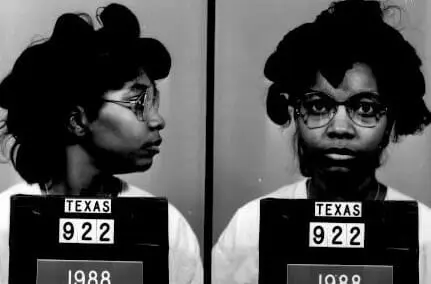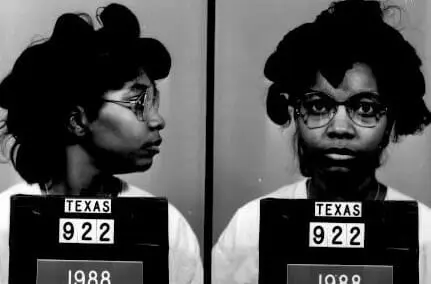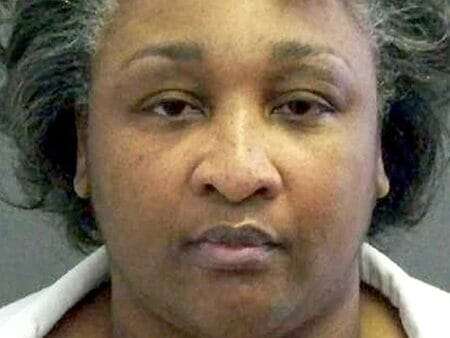
Lois Nadean Smith was executed by the State of Oklahoma for the murder of her sons ex girlfriend. Lois Nadean Smith was executed by lethal injection on December 4, 2001
Lois Nadean Smith was known as mean Nadean would hear that her sons ex girlfriend was going around trying to find someone to murder her son and that the woman would also tell police that Smith was dealing drugs.
Lois Nadean Smith and her son would find the ex girlfriend who would be stabbed in the throat by Smith before being forced into a vehicle. The victim would be driven to a home where she would be shot multiple times causing her death.
Lois Nadean Smith would be arrested, convicted and sentenced to death. On December 4, 2001 Smith would be executed by lethal injection
Lois Nadean Smith Videos
Lois Nadean Smith More News
Lois Nadean Smith, 61, was convicted of the July 4, 1982 murder of 21-year-old Cindy Baillee in Gans. Baillee was the former girlfriend of Smith’s son, Greg. Smith, along with her son and another woman, picked up Baillee from a Tahlequah motel early on the morning of the murder.
As they drove away from the motel, Lois Nadean Smith confronted Baillee about rumors that Baillee had arranged for Greg Smith’s murder – charges which Baillee denied. Smith choked Baillee and stabbed her in the throat as they drove to the home of Smith’s ex-husband in Gans. At the house, Smith forced Baillee to sit in a recliner and taunted her with a pistol, finally firing several shots. Baillee fell to the floor, and while her son reloaded the pistol, Smith laughed and jumped on Baillee’s neck. Smith then fired four shots into Baillee’s chest and two to the back of her head. An autopsy revealed nine gunshot wounds to Baillee’s body.
http://www.clarkprosecutor.org/html/death/US/smith746.htm
Lois Nadean Smith Other News
The evidence shows that Lois Nadean Smith, her son Greg, and Teresa Baker [DeMoss] picked up Cindy Baillee at a Tahlequah motel early on the morning of July 4, 1982. Baillee had been Greg’s girlfriend, but allegedly had made threats to have him killed.
As the group drove away from the motel, Lois Nadean Smith confronted Ms. Baillee with rumors that she had arranged for Greg’s murder. When Ms. Baillee denied making any threats or arrangements, appellant choked the victim and stabbed her in the throat with a knife found in the victim’s purse. The car traveled to the home of Jim Smith, the appellant’s ex-husband and Greg’s father in Gans, Oklahoma. Present at the house were Smith and his wife Robyn. [Robyn] left shortly after the group arrived.
While at the Smith house, appellant forced Ms. Baillee to sit in a recliner chair. Lois Nadean Smith then threatened to kill Ms. Baillee, and taunted her with a pistol. Finally, appellant fired a shot into the recliner, near Ms. Baillee’s head. She then fired a series of shots at Ms. Baillee, and the wounded victim fell to the floor. As Greg Smith reloaded the pistol, appellant laughed while jumping on the victim’s neck. Lois Nadean Smith took the pistol from Greg and fired four more bullets into the body. A subsequent autopsy showed Ms. Baillee had been shot five times in the chest, twice in the head, and once in the back. Five of these gunshot wounds were fatal. The knife wound was also potentially fatal.
https://caselaw.findlaw.com/us-10th-circuit/1120817.html
Frequently Asked Questions
Lois Nadean Smith Execution
Once known as “Mean Nadean,” Lois Nadean Smith went meekly to her death.
The 61-year-old Smith, gray-haired and wearing glasses, asked her victim’s family for forgiveness and embraced her faith before being executed by injection Tuesday night for killing her son’s ex-girlfriend in 1982.
“I want to say I’m sorry for the pain and loss I’ve caused you,” Smith said. “I ask that you forgive me. You must forgive to be forgiven.”
Lois Nadean Smith thanked her attorneys, sent her love to her children and then quoted Scripture.
“To live is Christ, to die is gain,” she said. “Thank you Jesus.”
Lois Nadean Smith was pronounced dead at 9:13 p.m., two minutes after the lethal mix of drugs was administered. Four of her attorneys, a spiritual adviser and an investigator watched from the front row of the witness room.
Lois Nadean Smith, the last female on death row in Oklahoma, was the third woman executed by the state this year. No state has executed as many women in one year since the death penalty was reinstated in 1976, according to the Death Penalty Information Center in Washington.
Lois Nadean Smith is the 17th person executed this year in Oklahoma. On Thursday, Iraqi national Sahib Al-Mosawi is scheduled to become the 18th, which would give Oklahoma more executions than any state _ Texas has had 16, with one more scheduled before year’s end.
Lois Nadean Smith was convicted of killing Cindy Baillie, 21, in Sequoyah County on July 4, 1982, because she thought Baillie was trying to have Smith’s son killed.
Baillie’s daughter, Brandy Fields, witnessed the execution with her husband, a family friend and an aunt.
“If she really meant it, you have to forgive even though it’s very hard and it doesn’t help me at all,” Fields said, sobbing occasionally. “It does a little bit, but it doesn’t bring back my mom.
“I wish she thought of this before she did what she did. We wouldn’t be in this position.”
Smith and her son, Greg, and another woman picked up Baillie in Tahlequah the morning of the killing, said Attorney General Drew Edmondson. Smith confronted her about rumors that she had threatened to have Greg Smith killed.
Prosecutors said Lois Nadean Smith, who had earned her nickname in high school, then began to choke Baillie and stabbed her in the throat with a knife. Baillie was driven to a home in Gans, where Nadean Smith shot her in the chest, head and back and jumped on her neck.
Greg Smith was convicted of murder and given a life sentence. He reloaded Smith’s gun during the shooting.
Fields said she will be at Greg Smith’s parole hearing in May.
“It’s not completely over because I still have to go and do that until he dies,” she said. “I’m glad this part of it’s over because I don’t ever have to hear that she’s got clemency or is going to stay the rest of her remaining life in prison. She’s got what the court handed down to her.”
Eight women were arrested Tuesday night while protesting Smith’s execution. They were held on misdemeanor trespassing complaints after crossing a police line at the Mabel Basset Correctional Center in Oklahoma City, where Smith was housed before being transferred to the Oklahoma State Penitentiary.
A small group of anti-death penalty protesters prayed by candle light outside the prison. Nearby, a group of victim’s advocates stood vigil. One wore a T-shirt that said, “The crime scene will return to normal. What about the victims?’
Lois Nadean Smith Other News
A woman convicted of killing her son’s former girlfriend in 1982 was executed Tuesday night by lethal injection, making her the third woman and 17th inmate put to death this year in Oklahoma.
With the execution of Lois Nadean Smith, 61, Oklahoma now leads the nation in the number of executions this year.
Texas has had 16 executions, with one more scheduled before year’s end. Oklahoma also has one more execution scheduled for this year. Sahib Al-Mosawi, an Iraqi national, was scheduled to die Thursday for killing his wife and her uncle.
Lois Nadean Smith was the last woman on Oklahoma’s death row. No state has executed as many women in one year since the death penalty was reinstated in 1976, according to the Death Penalty Information Center in Washington.
Before the drugs were administered, Smith thanked her attorneys and asked for forgiveness.
“To the families, I want to say I’m sorry for the pain and loss I’ve caused you,” Smith said. “I ask that you forgive me. You must forgive to be forgiven.”
Lois Nadean Smith was convicted of killing 21-year-old Cindy Baillie in July 1982. Baillie was shot nine times and stabbed in the throat.
Authorities said Smith and her son Greg picked up Baillie the morning of the killing. Smith then confronted her about rumors that she had threatened to have her son killed.
Prosecutors said Lois Nadean Smith began to choke Baillie and stabbed her in the throat with a knife; Baillie was then driven to a home where Lois Nadean Smith shot her.
Greg Smith was convicted of murder and given a life sentence. Prosecutors said he reloaded his mother’s gun during the shooting.
Lois Nadean Smith’s attorneys said she was trying to protect her son and was under the influence of alcohol and drugs at the time of the slaying.
https://www.latimes.com/archives/la-xpm-2001-dec-05-mn-11847-story.html
Lois Nadean Smith Son
Authorities in the city of Bozeman, Montana, have arrested a Cherokee County man who allegedly held a woman against her will inside a motel room for two months.
James Gregory Smith, 50 – a convicted Oklahoma murderer who is also wanted for warrants issued in Cherokee County – is being held for felony kidnapping and a misdemeanor charge of domestic assault. His bond in Montana has been set at $250,000.
According to a report published by the Bozeman Daily Chronicle, police in that community were dispatched to a motel last Friday when a woman called for help. When police found the woman, she claimed she had tried to flee from Smith in Colorado, but Smith had tracked her down in Bozeman.
The newspaper reports the woman said Smith had been assaulting her; that he threatened to kill her; and that he had kept her as a “prisoner” at the motel since early October.
The newspaper also reports Smith claims he and the alleged victim were drunk when he was arrested, and he denies holding her captive.
Court records show a bench warrant was issued for Smith’s arrest on Oct. 6 when he failed to appear in Cherokee County District Court.
Smith was accused of stabbing another man during a fight in September 2013, and was later charged with assault and battery with a deadly weapon.
He has also faced a string of other charges in Cherokee County, including assault and battery and possession of a controlled dangerous substance in August of this year; driving under the influence, unlawful possession of paraphernalia, and open container alcohol in June of this year; and driving while impaired in May 2014.
In 1982, prosecutors alleged Smith and his mother, Lois Nadean Smith, tortured and killed his ex-girlfriend, Cynthia L. Baillee, after picking her up in Tahlequah and driving her to Sequoyah County.
Baillee was choked and stabbed in the throat, shot nine times, and stomped on, according to reports of the murder.
Smith was 18 at the time and was given a life sentence, which was complete in 2009, according to state records. Lois Nadean Smith was executed for her part.
If Smith is convicted of his charges in Montana, he could face up to 10 years in prison and a fine of $50,000 for kidnapping.
Bozeman is a city about 140 miles west of Billings, Montana
Lois Nadean Smith FAQ
Why Was Lois Nadean Smith Executed
Lois Nadean Smith was executed for the murder of her sons ex girlfriend
When Was Lois Nadean Smith Executed
Lois Nadean Smith was executed on December 4, 2001








